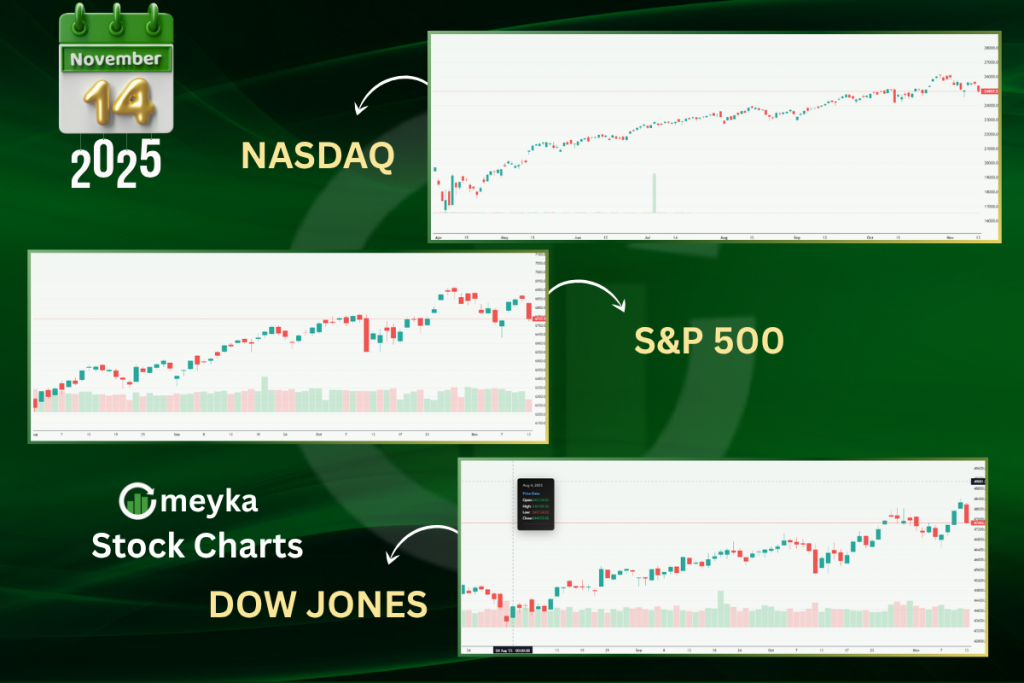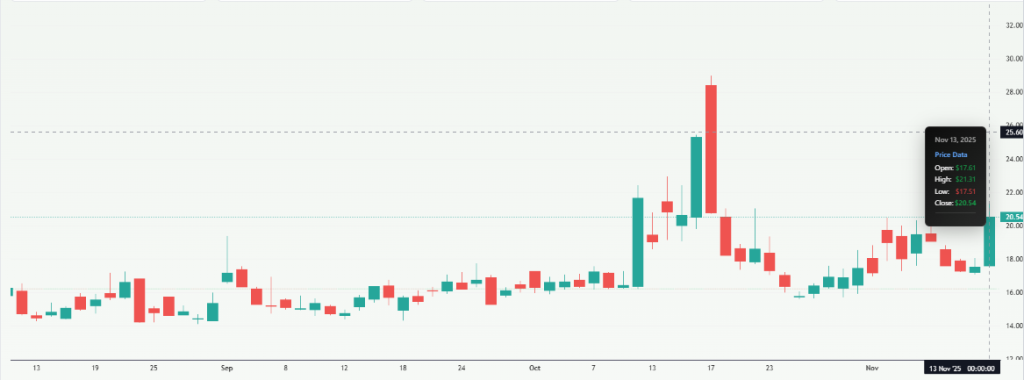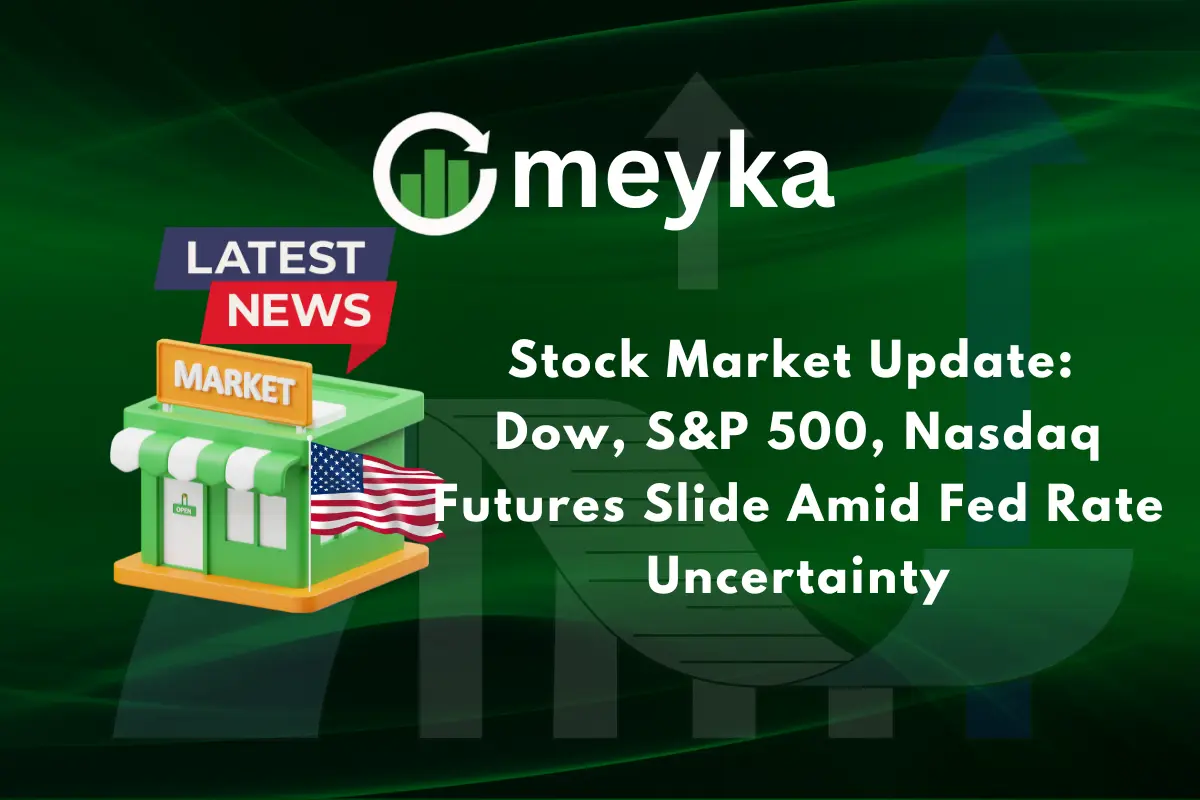Stock Market Update: Dow, S&P 500, Nasdaq Futures Slide Amid Fed Rate Uncertainty
On November 14, 2025, U.S. stock-futures markets registered a sharp retreat, hinting at a nervous day ahead for the main indexes. The Dow Jones Industrial Average, S&P 500, and Nasdaq Composite futures all slid as traders digested fresh signals from the Federal Reserve that the era of rate cuts may not arrive as soon as once hoped. Investors questioned whether the central bank will hold off on easing given persistent inflation risks and a strong labour market.
Meanwhile, escalating global growth concerns and mixed data out of Asia have added to the mood of caution. This blend of monetary-policy uncertainty and economic fragility has prompted many market participants to pause, step back, and reassess. It’s a moment when optimism is tempered, and the market seems to ask: what next for interest rates, and what does it mean for stocks?
Current Performance of the Dow, S&P 500, and Nasdaq
As of November 14, 2025, the U.S. stock market is trading lower across all major indexes. The S&P 500 sits near 6,720, showing a mild pullback after recent gains. The Dow Jones Industrial Average trades around 47,450, also edging lower.

The tech-heavy Nasdaq Composite hovers close to 22,870, extending its decline as rate-sensitive stocks face pressure. ETF tracking shows a similar trend, with SPY at $672.04, QQQ at $608.40, and DIA at $474.74, all in negative territory. These levels reflect cautious sentiment driven by ongoing uncertainty around the Federal Reserve’s next rate move.
What’s Driving the Stock Market Decline?
Fed uncertainty sits at the center of the move. Recent comments from Fed officials and Fed-related policy moves have pushed traders to rethink the timing of rate cuts. Many market participants had priced in a faster easing path. Those odds have now fallen. The result is a reassessment of valuations for rate-sensitive assets. This dynamic was a major force behind selling on November 13-14, 2025.
Economic Indicators in Focus
The Stock Market is unusually sensitive to any data that can change the Fed’s timeline. Inflation readings and payroll numbers are at the top of the list. The long government shutdown created gaps in official data earlier in November, leaving traders to rely on partial reports and private surveys. That added to the “fog” around the economy and raised the chance that the Fed will move more slowly than investors expect. In turn, investors sold riskier assets until clarity returns.
Sector Reactions and Leadership Change
Technology stocks led the downside. High-multiple growth names, which trade on expectations for future profit, fell hardest as higher-for-longer rates pushed down discount rates. Nvidia and other large-cap AI names saw notable pressure after earlier rallies.

Financials showed a mixed picture. Banks can profit from higher yields through wider net interest margins. Yet they also face slower loan growth if the economy softens. Industrials and consumer cyclicals responded to the changing growth outlook. Defensive sectors outperformed as investors rotated into lower-risk exposures.
Treasury Yields and the Dollar
Bond markets reflected the split view on the outlook. Short-term yields have dropped in places where traders still expect cuts. Longer-term yields nudged higher amid talk of more Treasury supply and stubborn inflation risks. That steepening removed some of the support for equity multiples.

The dollar showed strength on safe-haven flows and on expectations that U.S. rates may remain elevated longer than in other regions. A stronger dollar can dampen sales for U.S. exporters and pressure multinational earnings.
Volatility and Investor Mood

The VIX rose as equities slid. Rising implied volatility shows that traders are paying up to hedge downside risk. This jump in fear metrics also feeds selling, since leveraged players and trend funds may reduce exposure to limit losses. Sentiment surveys and private indicators show a move from complacency to caution. That shift can make rallies shallower and corrections deeper until a clearer policy signal arrives.
U.S. Stock Market & Global Spillovers
U.S. policy uncertainty translated quickly to global markets. Asian equities had mixed sessions after U.S. weakness. European markets opened lower on interest-rate jitters and weaker risk appetite. China’s growth concerns and geopolitical frictions added an extra layer of pressure on cyclicals and commodity-linked names. In short, the tone in U.S. futures echoed through other regions and reinforced the risk-off bias.
Earnings Season Interplay
Earnings remain a key near-term driver. Strong reports can blunt Fed worries if revenue and margin trends show resilience. Conversely, disappointing guidance will worsen the growth-versus-inflation debate. Tech earnings, in particular, will set the tone for Nasdaq futures. Firms that announce conservative outlooks risk sharper share-price drops as the market weighs rate risk against profit prospects.
Analyst Views and Market Strategy
Analysts are split. Some see the pullback as a buying chance given long-term growth prospects for AI and cloud computing. Others warn that stretched valuations need more time to absorb higher rates. Traders are watching Fed communications closely for clues on balance-sheet policy and the timing of a first cut. Many are also using an AI stock research analysis tool to scan earnings and macro patterns faster. That technology can highlight risks early, but it does not remove uncertainty about policy choices.
What to Watch Next?
Key items include upcoming inflation readings, the next payroll report, and any Fed speeches or committee minutes released in the coming days. Market participants will also track corporate guidance through the rest of earnings season. A surprise inflation uptick or strong jobs print would lower the probability of near-term cuts. Conversely, softer data could reopen the path to easing and calm markets. Mark calendar dates and read statements closely for nuance.
Scenario Framing for Investors
If the Fed signals patience, expect further choppy trading and continued pressure on growth stocks. If the Fed signals readiness to cut, markets could rebound, led by cyclicals and recovery trades. Risk management is essential in either path. Consider time horizons, position sizing, and hedges. Keep liquidity in mind, since volatile conditions can widen bid-ask spreads and make entry points more costly.
Wrap Up
On November 14, 2025, futures reflected a market in search of clarity. The core issue is simple: the Fed’s next moves will set the tone for months. Until data offers a clearer signal, expect uneven markets, swift rotations across sectors, and elevated volatility. Watch policy clues and corporate guidance closely. Those signals will guide where prices head next.
Frequently Asked Questions (FAQs)
The indexes are down on November 14, 2025, because traders are unsure about future Fed rate moves. This uncertainty makes investors pull back and avoid risk for now.
When the Fed’s next rate step is unclear, investors worry about borrowing costs. This worry leads to slower buying and more selling, which pushes markets lower.
Investors should watch inflation numbers, jobs data, and Fed comments. These reports guide expectations and help show if markets might rise or fall soon.
Disclaimer: The content shared by Meyka AI PTY LTD is solely for research and informational purposes. Meyka is not a financial advisory service, and the information provided should not be considered investment or trading advice.






